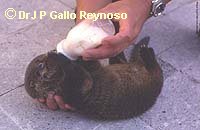Title of Page
This is mainly from Larivire 1999.Some populations of Neotropical Otters seem to breed only once a year, in the Spring, whereas others may breed at any time. The male stays with the female for about day, then has no further contact with her or the cubs.
Larivire gives average gestation as 56 days, So Paulo Zoo as 60 days, and Arcila & Ramirez as 86 days (although they say they may have missed a later mating). Lariviere says there is some evidence of facultative implantation, but the delay is unknown. The variable breeding season may indicate that some populations show the same implantation delay as the North American River Otter, so breeding only once a year, or females may only come into oestrus once a year. Blacher (1994), working with captive L. longicaudis, found, however, that in Brazil breeding occured all year round, presence of the male when cubs were born led to the female abandonning them (which indicates that the male does not play a part in cub-rearing) and that delayed implantation does not take place.
 Between
one and six cubs may be born, although cub mortality before emergence is
unknown - many litters may start larger than the number that survive to
emergence in the wild, whereas in captive studies, the animals are more
closely observed. The young are born blind but fully-furred as with all
otters; their eyes open at around 44 days. They first start leaving the
den at about 52 days, playing around the entrance of the natal holt. At
around 74 days, their mother starts to teach them to swim. The
juveniles reach sexual maturity at around 2 years old, but nothing is
known about dispersal in this species.
Between
one and six cubs may be born, although cub mortality before emergence is
unknown - many litters may start larger than the number that survive to
emergence in the wild, whereas in captive studies, the animals are more
closely observed. The young are born blind but fully-furred as with all
otters; their eyes open at around 44 days. They first start leaving the
den at about 52 days, playing around the entrance of the natal holt. At
around 74 days, their mother starts to teach them to swim. The
juveniles reach sexual maturity at around 2 years old, but nothing is
known about dispersal in this species.
Lifespan in the wild is unknown, but is likely to be less than half the captive record of 25 years recorded by So Paulo Zoo.
| Neotropical River Otter |

